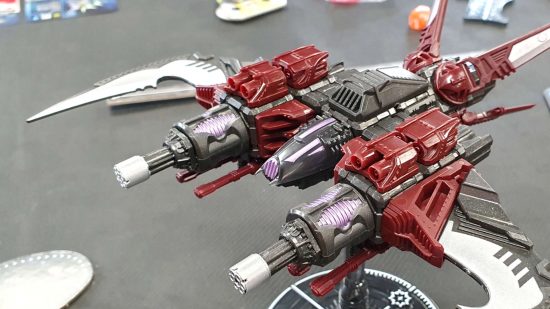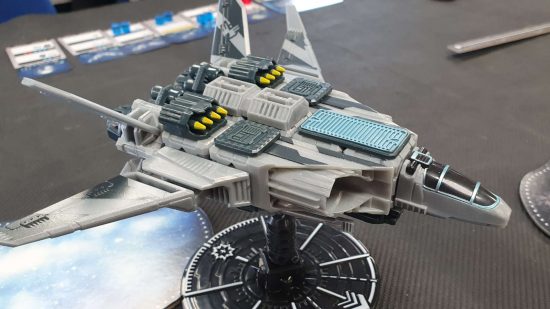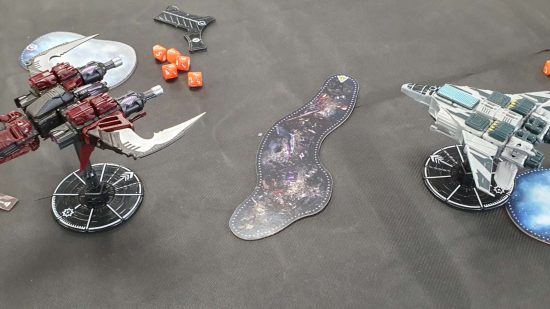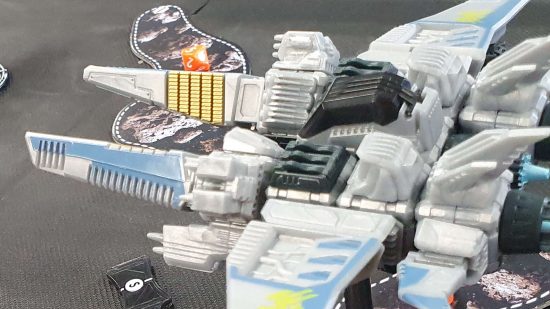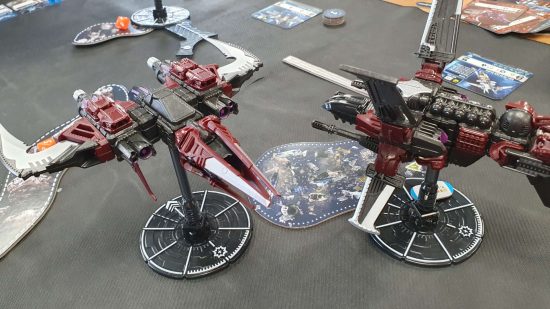Our Verdict
A construction toy and a space dogfighting game in one, Snap Ships Tactics packs remarkable replay value into one box, built on a core of solid rules and chunky blocks.
Snap Ships is a construction toy range with a single purpose – to make kick-ass spaceship after kick-ass spaceship. Snap Ships Tactics takes those construction toys, sticks them onto flight stands, and adds rules for dogfights in the void of outer space. If you’ve ever picked up a toy spaceship and started making noises like: “Pew pew pew! Zoom! Nyeeeeew!”, this is probably for you.
The Snap Ships Tactics starter box contains the parts for two spaceships, the Scarab and the Sabre. Starting with a chassis of pop-together blocks, you’ll socket an assortment of guns, wings, engines, and gubbins to the outside. As preparing the figures for a miniature wargame goes, this is a lot simpler than constructing a Warhammer 40k starter set.

Snap Ships offer a very simple construction experience compared to the best LEGO sets, with a very limited range of expression – but that focus is not a bad thing. Snap Ships makes cool spaceships, and nothing but cool spaceships. The urge to pick them up, whirl them around your head, and make “Bzzzooom! Nyeeeeow!” noises is hard to resist.
With such a quick set-up, Snap Ships Tactics resolutely passes Ash Barker’s Christmas Morning Test. A kid could receive this as a gift, unwrap the box at breakfast, and be playing a game before the turkey is carved. The rules inside are well written, well organised, and just generally comprehensible, so they won’t form any sort of a barrier to getting started.
Players take it in turns activating their ship (or one of their ships, in larger games). They’ll first reset the ship’s evasion value to its basic level, then make a mandatory move. After that they vent power and heat from the ship’s various Parts, rendering them ready to use.
Every Snap Ship component has a corresponding Part card, and the selection of Parts attached to a ship give it its identity. Thrusters provide you with additional movement or evasion, wings allow you to make tricky manoeuvres, guns and missiles are your firepower. Parts are activated during your turn by adding energy cubes (and sometimes heat cubes) from your supply, and can’t be used again until that energy and heat is cleared.
Each chassis comes with a recommended loadout; the basic Sabre XF-23 is a mid range missile boat, capable of a mean U-turn, while the Scarab K.L.A.W. Interceptor can make deft sideways jinks and melee ram attacks. The Sabre and the Scarab both have three different chassis options in the box, each with its own game characteristics; that’s before you start mixing and matching components between chassis.
Most attacks are resolved by rolling some dice, aiming for a target number that increases along with the target’s current evasion score. Missiles are different – you’ll place a number of missile tokens onto the target’s chassis card. Its controller has until the end of its next activation to shoot them down with counterfire, or boost its evasion, before they explode.
Cardboard templates for ice clouds, asteroid fields, or spinning debris, provide you with cover and add further wrinkles to the battlefield. Ice clouds vent the heat that builds up in your ship’s most powerful components, while entering an asteroid field might blow up the missiles on your tail.
In test games I found that even one vs one dogfights were compelling; there was never just one, obvious strategy for my turn. Suppose you’re in the right position for an attack, but your opponent’s evasion is very high – a clear hit could knock out one of their systems, but is it worth swamping your best guns with energy and heat when you might miss? What if you’ve got a clear shot, but a flight of missiles is homing in on your tail?
That’s just a fight to the death, with no objectives. The core box has rules for solo and co-op play, and three missions that mix things up substantially.
Wargamer also got sent an expansion pack with two further ships, plus a separate box of stands, and another of stat cards for the new ship chassis and their components. These are flatly more powerful, and add advanced capabilities compared to the ships in the box: the default loadout of the K.L.A.W. Heavy Fighter makes it a long-distance railgun platform, lethal against anything it can get a direct line of fire on.
There’s a basic balancing system, with different ship sizes worth more or less points, but this doesn’t account for the relative strength of different components. Tournament gamers would break this system over their knee. The game isn’t made for them; it’s made for players who want to chop and change the lasers and go-faster fins on their cool toy spaceships.
As far as criticisms go, once you start losing it can be hard to pull back: damaged systems can be repaired, but doing so is another thing to juggle along with your energy and the heat on your systems. The deployment rules also give the second player a real advantage, as they can line up their long-range weapons perfectly when their ship enters the battle-zone.
Yet I don’t want to downplay the sheer quantity of fun to be had here. Snap Ships Tactics bridges the gap between the childish glee of smashing toy spaceships together, and the (slightly) more cerebral pleasures of miniature wargaming. If you know a young gamer who isn’t embarrassed by their childhood interests, this is a game they could play by themselves, with friends or siblings, or with the grown-ups in their life.
For grown-ups considering this for themselves, the question is simple. Suppose someone hands you a toy spaceship. Do you make spaceship noises? If so, you’ll love this.
